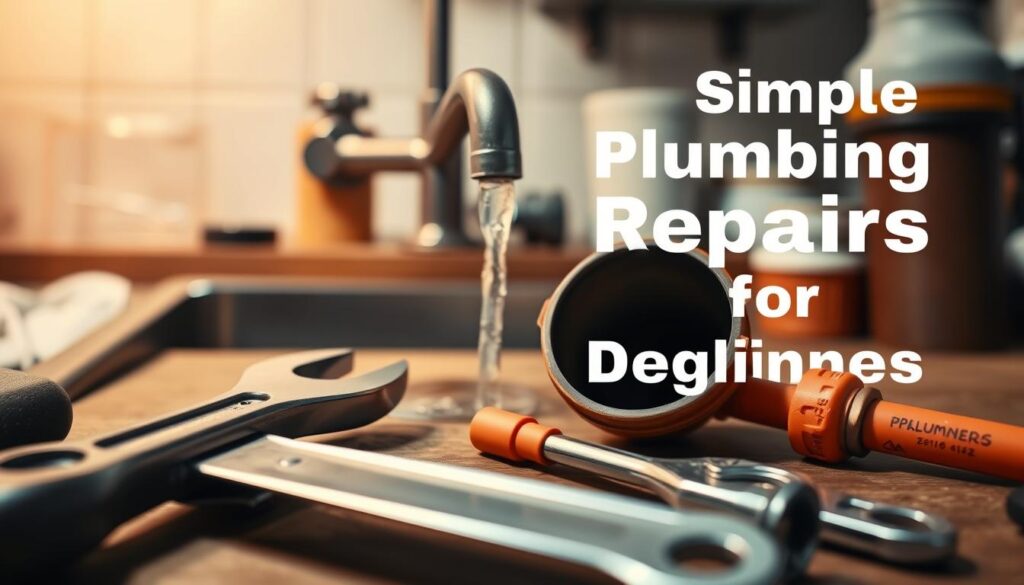As a homeowner, having basic plumbing skills can be a game-changer. Imagine being able to fix a leaky faucet or unclog a drain without calling a professional, saving you both time and money.
Learning basic plumbing repairs is a wise investment for any homeowner. By acquiring these skills, you can tackle small issues before they escalate into major problems, ensuring your home remains safe and functional.
Key Takeaways
- Learn basic plumbing skills to save time and money
- Fix common issues like leaky faucets and clogged drains
- Be self-sufficient in maintaining your home’s plumbing system
- Identify potential problems before they become major disasters
- Acquire a valuable skill that enhances your homeownership experience
Understanding Basic Plumbing Concepts
Before diving into DIY plumbing projects, it’s crucial to understand the underlying plumbing concepts. This foundational knowledge will empower newcomers to tackle projects with confidence.
Understanding the basics of plumbing is crucial for making informed decisions about your plumbing system. The three primary systems are water supply, water heating, and drainage. Each plays a vital role in the overall functioning of your home’s plumbing.
Types of Plumbing Systems
Plumbing systems can be categorized into three main types: water supply systems, drainage systems, and water heating systems. Water supply systems bring fresh water into your home, while drainage systems remove wastewater. Water heating systems, on the other hand, are responsible for providing hot water.
For a deeper dive into plumbing basics, you can visit https://teamenoch.com/blog/plumbing-basics/ to explore more resources on getting started with DIY plumbing projects.
Common Plumbing Terminology
Familiarizing yourself with common plumbing terminology can help you navigate DIY projects more effectively. Terms like “P-trap,” “aerator,” and “shut-off valves” are frequently used in plumbing contexts. Understanding these terms will make it easier to follow instructions and communicate with professionals when needed.
By grasping these basic concepts and terminology, DIY newcomers can lay a solid foundation for more complex plumbing projects in the future.
Essential Tools Every Beginner Needs
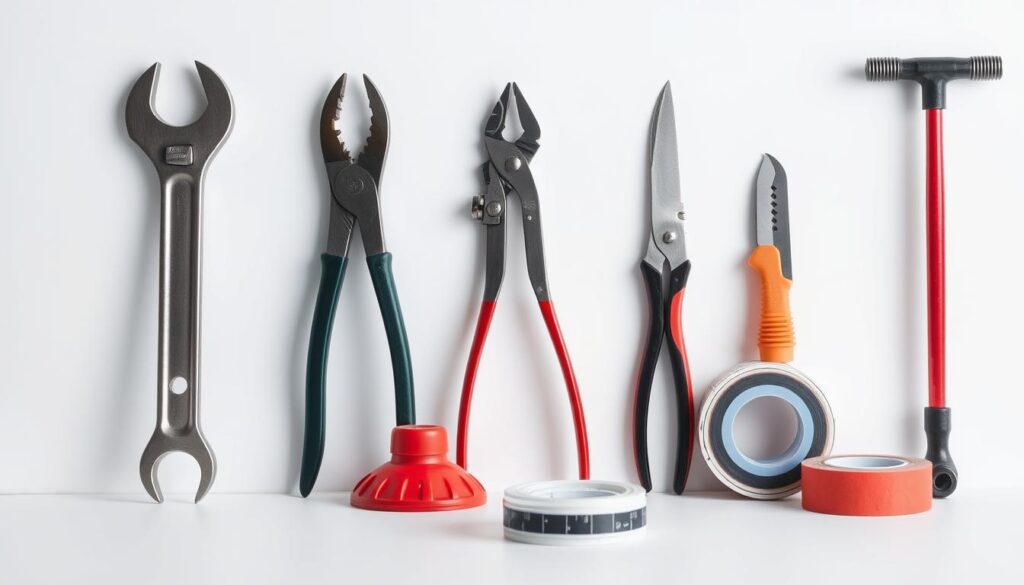
For beginners, having the right plumbing tools is crucial for efficient and safe repairs. Understanding the basics can make a significant difference in the outcome of your plumbing projects.
Must-Have Plumbing Tools
To tackle basic plumbing fixes, you’ll need a variety of tools. These include:
- Adjustable wrenches for gripping and twisting pipe fittings
- Slip-joint pliers for gripping and bending objects
- Pipe cutters for cutting through pipes cleanly
- Tubing benders for bending tubing without kinking it
- Teflon tape for creating watertight seals on threaded pipe connections
As noted by experts, “Having the right tool for the job can make all the difference in the efficiency and quality of your work.” Learning about the best plumbing tools can further enhance your plumbing skills.
| Tool | Use |
|---|---|
| Adjustable Wrench | Gripping and twisting pipe fittings |
| Slip-Joint Pliers | Gripping and bending objects |
| Pipe Cutters | Cutting through pipes cleanly |
Safety Gear for Plumbing Repairs
Safety should always be a top priority when performing plumbing repairs. Essential safety gear includes:
- Gloves to protect your hands from cuts and abrasions
- Safety glasses to protect your eyes from debris
- A face mask to prevent inhalation of dust and other particles
Always ensure you’re working in a well-ventilated area and follow proper safety protocols to avoid accidents.
Diagnosing Common Plumbing Problems
Understanding how to identify plumbing issues is key to easy plumbing maintenance for starters. Common plumbing problems can lead to significant inconvenience and costly repairs if not addressed promptly.
Leaky Faucets
A leaky faucet is not only annoying, but it also wastes water and increases your utility bills. To diagnose a leaky faucet, look for signs such as:
- Drips or drops of water from the faucet
- Water pooling around the faucet base
- Increased water bills without a corresponding increase in usage
Identifying the source of the leak is crucial. Check the faucet’s washers, O-rings, and valve seats for wear or damage.
Running Toilets
A running toilet can waste a significant amount of water. To diagnose the issue, listen for continuous running water sounds when the toilet is not in use. Check the:
- Flapper for proper sealing
- Float arm for correct adjustment
- Fill valve for proper function
Adjusting or replacing these components can often resolve the issue.
Clogged Drains
Clogged drains are a common plumbing problem that can cause backups and odors. To diagnose a clogged drain, look for signs such as:
- Slow draining water
- Gurgling sounds from the drain
- Water backing up into the sink or tub
Using a plunger or drain snake can often clear the clog. For more stubborn clogs, consider using natural remedies or calling a professional.
By understanding how to diagnose these common plumbing problems, homeowners can take the first step towards easy plumbing maintenance for starters and avoid more costly repairs down the line.
How to Fix a Leaky Faucet
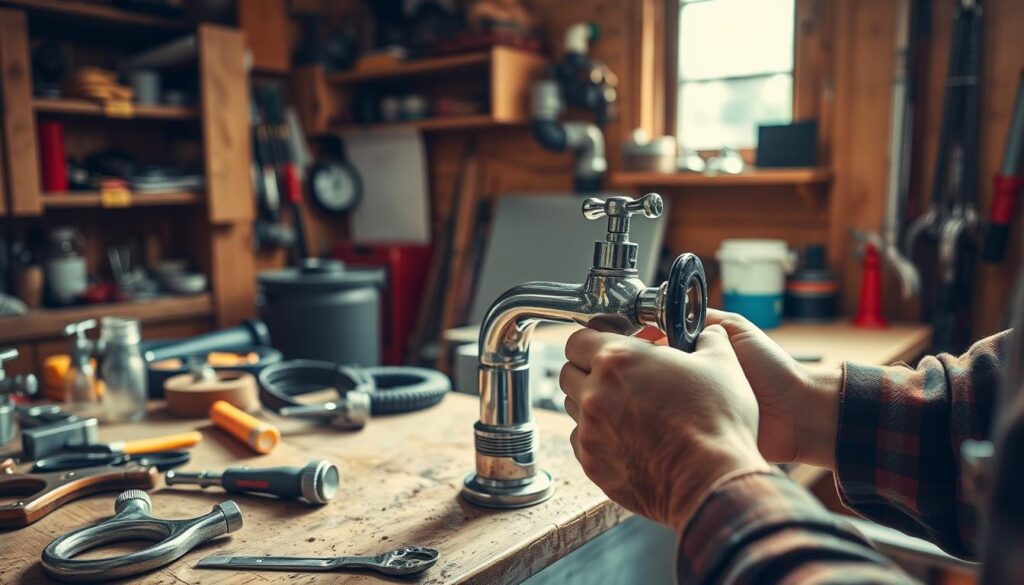
Repairing a leaky faucet is a straightforward process that beginners can master. Not only will fixing the leak save water, but it will also reduce your water bill. The process involves a few simple steps that can be completed with basic tools.
Identifying the Source of the Leak
The first step in fixing a leaky faucet is to identify where the leak is coming from. Common sources of leaks include worn-out washers, damaged O-rings, or loose connections. To identify the source, turn on the faucet and observe where the water is coming from.
- Check the faucet’s handle and base for signs of moisture.
- Inspect the drain and surrounding areas for any water droplets.
- Examine the faucet’s aerator for mineral buildup or debris.
Replacing Washers and O-Rings
Once you’ve identified the source of the leak, the next step is to replace the faulty parts. For most leaky faucets, this involves replacing the washers or O-rings. To do this:
- Turn off the water supply to the faucet.
- Disassemble the faucet to access the worn-out parts.
- Remove the old washer or O-ring and replace it with a new one.
Reassembling the Faucet
After replacing the necessary parts, reassemble the faucet in the reverse order that you disassembled it. Make sure all connections are secure and not over-tightened. Turn on the water supply and check the faucet for leaks.
By following these simple steps, you can fix a leaky faucet and start saving water and money. Regular maintenance, such as checking for worn-out parts, can also help prevent future leaks.
Repairing a Running Toilet
If your toilet is running continuously, it’s essential to address the issue promptly to avoid wasting water. A running toilet can lead to higher water bills and put unnecessary strain on your plumbing system.
Identifying the Issue
The first step in repairing a running toilet is to identify the source of the problem. Typically, the issue lies with the flapper or the floater. The flapper is the rubber valve that covers the hole at the bottom of the tank, and the floater is the mechanism that rises and falls with the water level in the tank.
To diagnose the problem, start by checking the water level in the tank. If the water level is too high, water will continuously flow into the overflow tube, causing the toilet to run.
Adjusting the Floater
If the issue is with the floater, adjusting it may resolve the problem. The floater needs to be set so that it shuts off the water supply when the tank is full. To adjust the floater, you may need to bend the arm it’s attached to or adjust the screw that controls the water level.
Tip: Make sure the floater is not stuck or tangled, as this can prevent it from functioning correctly.
Replacing the Flapper
If adjusting the floater doesn’t solve the issue, the problem might be with the flapper. Over time, the flapper can become worn out or damaged, preventing it from sealing properly. Replacing the flapper is a relatively simple process that involves detaching the old flapper and attaching a new one.
Remember: When replacing the flapper, ensure it’s the correct size and type for your toilet model.
By following these steps, you can repair a running toilet and save water. DIY plumbing projects like this are great for newcomers, as they help you understand your plumbing system better and save money on repair costs.
Clearing a Clogged Drain
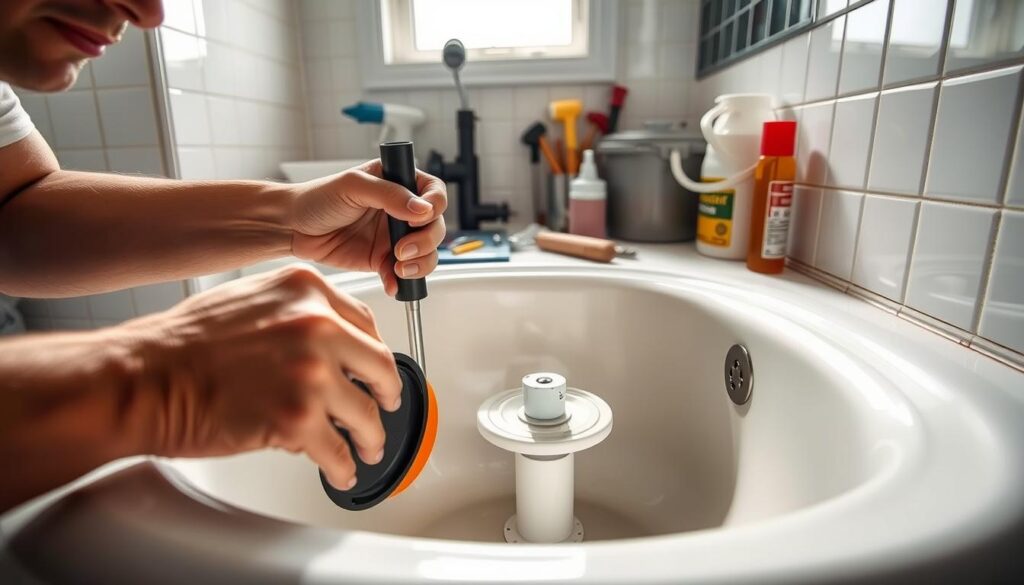
Clearing a clogged drain is a task that can be accomplished with the right tools and techniques. Clogged drains are a common issue in many households, causing inconvenience and potential water damage if not addressed promptly.
Using a Plunger
A plunger is one of the most effective and simplest tools for clearing a clogged drain. To use a plunger, ensure the drain is filled with enough water to cover the plunger’s cup. Then, plunge vigorously to create suction that can dislodge the clog. For best results, make sure the plunger is properly seated over the drain.
Using a Drain Snake
A drain snake, also known as an auger, is a flexible rod that can be inserted into the drain to break up or retrieve clogs. To use a drain snake, feed the cable into the drain until you feel resistance, then rotate the handle to break up the clog. This method is particularly effective for clogs that are further down the pipe.
Natural Remedies for Clogs
For those looking for a non-invasive approach, natural remedies can be an effective way to clear clogs. A mixture of baking soda and vinegar can be poured down the drain to help dissolve grease and other debris causing the clog. For instance, pour 1/2 cup of baking soda down the drain, followed by 1/2 cup of vinegar. Let it sit for a few hours or overnight before rinsing with hot water. This method is not only eco-friendly but also safe for your pipes.
For more complex or persistent clogs, it may be necessary to consult a professional. Companies like those found on 24/7 Construction & Repair offer trusted solutions for such plumbing issues.
Replacing a Showerhead
Changing your showerhead is an easy DIY task that requires minimal tools. It’s a simple yet effective way to enhance your showering experience, improving water pressure and overall quality.
Before you start, it’s essential to choose the right showerhead for your needs. With various types available, including rainfall, massage, and low-flow showerheads, selecting the correct one can make a significant difference.
Choosing the Right Showerhead
When selecting a new showerhead, consider factors such as water pressure, flow rate, and spray pattern. If you have low water pressure, a showerhead with multiple settings can help improve your shower experience.
- Rainfall showerheads provide a luxurious, spa-like experience.
- Massage showerheads offer various spray patterns for a more invigorating shower.
- Low-flow showerheads are ideal for water conservation and reducing your utility bills.
Tools Needed for the Job
To replace your showerhead, you’ll need a few basic tools. These include:
| Tool | Description |
|---|---|
| Adjustable wrench | For loosening and tightening the showerhead |
| Teflon tape | For creating a watertight seal on threaded connections |
| New showerhead | Your chosen replacement showerhead |
With these tools and your new showerhead, you’re ready to start the replacement process. Ensure the water supply is turned off before you begin.
Replacing a showerhead is a straightforward process that can significantly enhance your bathroom experience. By choosing the right showerhead and having the necessary tools, you can enjoy improved water pressure and quality.
Fixing Low Water Pressure
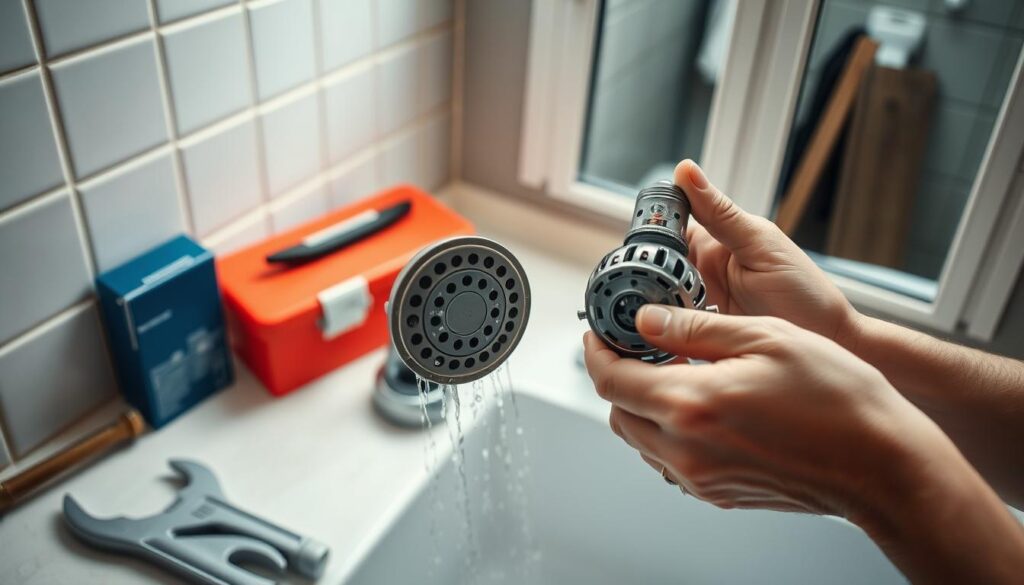
Fixing low water pressure requires a bit of troubleshooting to determine whether the issue is due to clogs or a malfunctioning pressure regulator. Low water pressure can significantly impact the comfort and functionality of your home’s plumbing system.
Checking for Clogs
The first step in addressing low water pressure is to check for clogs in your pipes. Clogs can occur due to mineral buildup, debris, or other obstructions. To check for clogs, start by inspecting the aerators on your faucets. Remove and clean the aerators to ensure they are not blocked. For more complex clogs, you may need to use a drain snake or plumber’s auger to clear the blockage.
For more information on dealing with clogs and other plumbing issues, you can visit emergency contractor services for professional assistance.
Adjusting Pressure Regulator
If checking for clogs doesn’t resolve the issue, the problem might lie with your home’s pressure regulator. The pressure regulator is a critical component that ensures the water pressure in your home remains at a safe and functional level. To adjust the pressure regulator, first, locate it. It’s typically found near the water meter or where the water line enters your home. Once located, you can adjust the regulator by turning the screw or bolt clockwise to increase pressure or counterclockwise to decrease it. However, be cautious not to over-adjust, as this can lead to other issues.
To ensure you’re maintaining the right water pressure, consider consulting resources like what is the right water pressure for your for guidance.
| Cause | Symptoms | Fix |
|---|---|---|
| Clogged Pipes | Low water pressure, slow drainage | Use a drain snake or plumber’s auger to clear clogs |
| Malfunctioning Pressure Regulator | Inconsistent water pressure | Adjust or replace the pressure regulator |
By following these steps and understanding the causes of low water pressure, you can apply the necessary fixes to restore your home’s water pressure to normal levels. For more plumbing tips for beginners, continue exploring our guide.
Repairing or Replacing a Sinking Sink
The moment you notice your sink sinking, it’s crucial to assess the situation to avoid more significant problems down the line. A sinking sink can be a sign of a more substantial issue, such as worn-out or damaged supporting structures beneath it.
Before diving into repairs, understanding the cause is essential. The sink’s condition could be due to various factors, including worn-out brackets, damaged countertops, or even issues with the sink’s installation.
Assessing Damage
To begin the repair process, you first need to assess the damage. Check the sink’s supporting brackets and the condition of the countertop around it. Look for any signs of wear, damage, or deterioration that could be causing the sink to sink.
- Inspect the brackets and clips that hold the sink in place.
- Check the countertop for any cracks or damage.
- Verify if the sink is properly installed.
For a more detailed assessment, consider the following table that outlines common issues and their potential causes:
| Issue | Potential Cause |
|---|---|
| Sink Sinking | Worn-out brackets |
| Countertop Damage | Water leakage |
| Improper Installation | Lack of proper sealing |
Step-by-Step Repair Instructions
Once you’ve identified the cause, you can proceed with the necessary repairs. For beginners, fixing a leaking kitchen sink can provide valuable insights into the repair process.
Here’s a step-by-step guide to repairing a sinking sink:
- Turn off the water supply: Before starting any repair, ensure the water supply to the sink is turned off.
- Remove the sink: If necessary, remove the sink to inspect and repair the underlying structure.
- Inspect and replace damaged parts: Check the brackets, clips, and other supporting structures. Replace any damaged parts.
- Reinstall the sink: Once repairs are done, reinstall the sink, ensuring it’s properly secured.
By following these steps, you can effectively repair or replace a sinking sink, ensuring it remains secure and functional. For more complex issues or if you’re unsure about any part of the process, consider consulting a professional.
Basic Pipe Repairs
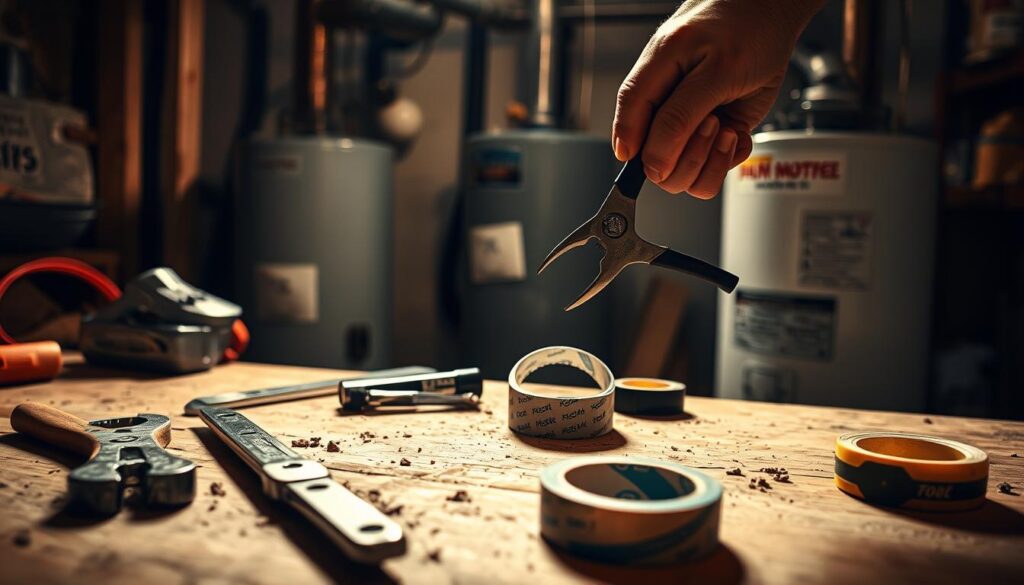
Understanding how to fix pipes is a valuable skill for homeowners, allowing them to address issues promptly and efficiently. Pipe repairs involve either patching small leaks or replacing damaged pipes entirely. Identifying the extent of the damage is crucial for determining the best course of action.
Patching Small Leaks
Small leaks can often be patched using plumbing epoxy or pipe repair clamps. For a leak in a visible and accessible pipe, turn off the water supply before applying the repair solution. For epoxy, clean and dry the area around the leak, then apply the epoxy according to the manufacturer’s instructions. For a pipe repair clamp, place it over the leak and tighten it securely.
It’s essential to monitor the repair to ensure the leak is fully fixed. If the leak persists, it may be necessary to consider more extensive repairs or consult a professional.
When to Replace Pipes
Not all pipe damage can be repaired with a simple patch. If a pipe is extensively corroded, damaged over a large area, or if the leak is significant, it may be more cost-effective and safer to replace the pipe entirely. For more complex issues or if you’re unsure about the extent of the damage, consulting a professional plumber is advisable. You can find more information on basic plumbing repairs on our website at https://hi-spec.com/blogs/news/basic-plumbing-repairs-every-homeowner-should-know.
Replacing pipes can be a more involved process, requiring additional tools and potentially professional assistance. However, it’s a crucial step in maintaining the integrity of your home’s plumbing system.
Understanding Water Supply Lines
Understanding water supply lines is crucial for maintaining a functional plumbing system in your home. Water supply lines are responsible for delivering water to various fixtures and appliances, making them a vital component of your home’s infrastructure.
Types of Water Supply Lines
There are several types of water supply lines, each with its own characteristics and benefits. The most common types include:
- Copper pipes: Known for their durability and resistance to corrosion.
- PEX pipes: Flexible and resistant to freezing temperatures.
- PVC pipes: Affordable and resistant to corrosion.
Choosing the right type of water supply line depends on various factors, including local building codes, water pressure, and personal preference.
Common Issues to Watch For
Water supply lines can be prone to various issues, including leaks, corrosion, and damage from freezing temperatures. Regular inspection and maintenance can help identify potential problems before they become major issues.
Common signs of water supply line issues include:
- Water leaks or drips.
- Discolored water.
- Reduced water pressure.
By understanding the types of water supply lines and common issues to watch for, you can take proactive steps to maintain your home’s plumbing system and prevent costly repairs.
As a beginner, it’s essential to be aware of the importance of easy plumbing maintenance for starters to ensure the longevity of your water supply lines and overall plumbing system.
Simple Toilet Repairs
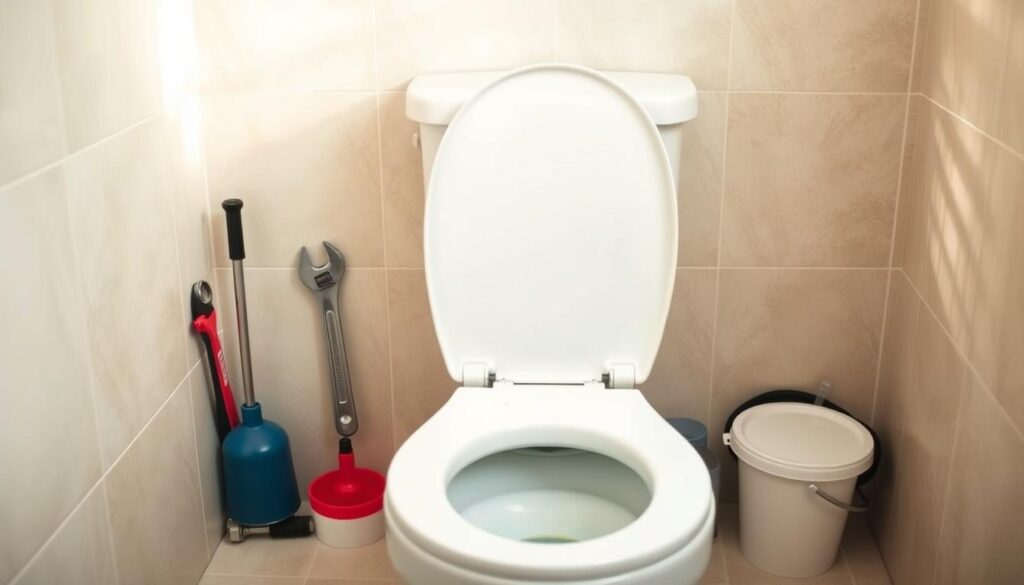
Simple toilet repairs can save you money and reduce water waste. Toilets are one of the most used fixtures in any home, and when they malfunction, it can be both inconvenient and costly. Fortunately, many common toilet issues can be resolved with basic DIY skills.
Fixing a Stuck Flapper
A stuck flapper is a common issue that can cause water to continuously flow into the toilet bowl. To fix this, you’ll first need to turn off the water supply to the toilet. This is usually done by locating the shut-off valve behind the toilet and turning it clockwise. Once the water supply is off, you can inspect the flapper for any debris or mineral buildup that might be causing it to stick.
Step-by-Step Fix:
- Remove the tank lid and inspect the flapper.
- Clean any debris or mineral deposits.
- If the flapper is damaged, consider replacing it.
Tightening Loose Connections
Loose connections can lead to leaks, which not only waste water but can also cause damage to your bathroom. To tighten loose connections, you’ll need to identify where the leak is coming from. Common areas include the tank-to-bowl connection and the supply line.
Tightening Process:
- Turn off the water supply.
- Inspect the connections for signs of leakage.
- Use a wrench to tighten any loose fittings.
- Check for leaks after tightening.
By following these simple steps, you can resolve many common toilet issues on your own, saving you the cost of calling a plumber and reducing your water bill.
Common Issues with Water Heaters
As a beginner in plumbing repairs, recognizing the signs of water heater malfunction is the first step towards resolving issues efficiently. Water heaters are a crucial part of household plumbing, providing hot water for various needs. However, they can malfunction due to various reasons, leading to inconvenience and potential safety hazards.
Identifying Signs of Malfunction
Identifying the signs of a malfunctioning water heater is crucial for timely intervention. Common indicators include:
- Insufficient hot water
- Leaks around the water heater
- Unusual noises coming from the water heater
- Discolored water
These signs suggest that the water heater is not functioning correctly and may require immediate attention.
Basic Troubleshooting Steps
Once you’ve identified a potential issue with your water heater, basic troubleshooting steps can help resolve the problem. For instance, checking the power supply and ensuring the thermostat is set correctly can often resolve issues. For electric water heaters, checking the circuit breaker or fuse box is a good starting point. For more complex issues, referring to a detailed guide like the one on repairing an electric water heater can be helpful.
| Issue | Troubleshooting Step |
|---|---|
| Insufficient Hot Water | Check thermostat settings and heating elements. |
| Leaks | Inspect connections and tank for damage. |
| Unusual Noises | Check for sediment buildup and consider flushing the tank. |
By understanding the common issues with water heaters and following basic troubleshooting steps, beginners can perform simple plumbing repairs, ensuring their water heaters function efficiently and safely.
Seasonal Plumbing Maintenance Tips
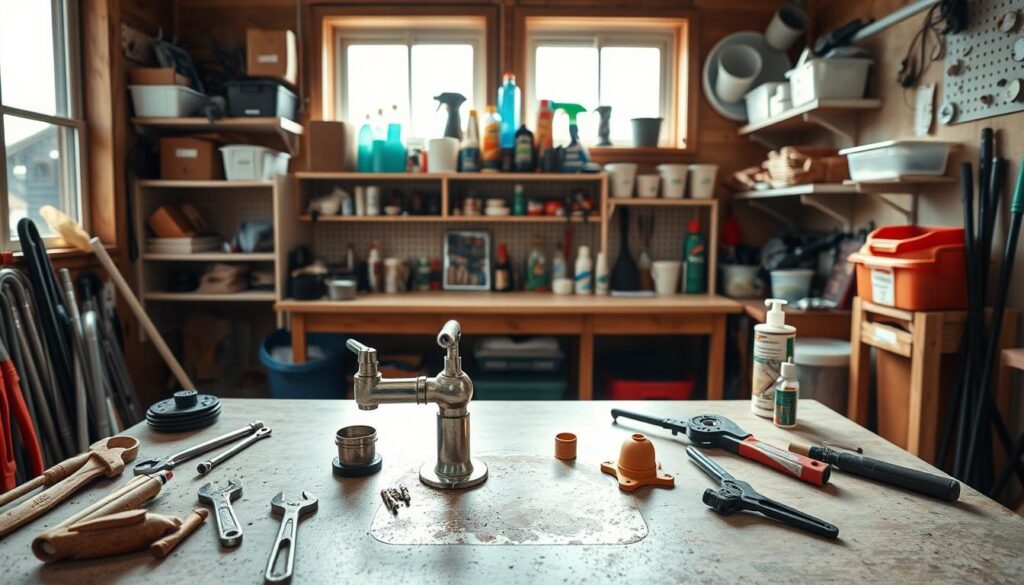
As the seasons change, it’s essential to adjust your plumbing maintenance routine to prevent issues and ensure your system runs smoothly. Regular maintenance can help you avoid costly repairs and reduce the risk of plumbing emergencies.
Preparing for Winter
Winter can be harsh on your plumbing system, so it’s crucial to prepare your pipes and fixtures for the cold weather. Here are some steps to take:
- Insulate exposed pipes in unheated areas like the garage, basement, or crawlspace.
- Drain and disconnect hoses from outdoor faucets.
- Seal any cracks or gaps in your home’s foundation with caulk or spray foam.
- Let cold water drip from faucets served by exposed pipes.
Key Winter Preparation Tips:
- Check your water heater’s temperature and pressure relief valve.
- Consider installing freeze-proof faucets or frost-proof spigots.
Spring Cleaning Checklists
Spring is the perfect time to inspect your plumbing system and address any issues that may have arisen during the winter. Here’s a checklist to follow:
- Inspect your pipes for signs of leaks or damage.
- Check your water meter for any signs of hidden leaks.
- Clean your faucet aerators and showerheads.
- Check your toilet flapper and fill valve for proper function.
By following these seasonal plumbing maintenance tips, you can help ensure your plumbing system runs efficiently and effectively throughout the year. Remember, regular maintenance is key to preventing costly repairs.
Knowing When to Call a Professional
DIY plumbing repairs are cost-effective, but identifying when to call a professional is key to avoiding further damage. As you undertake easy plumbing maintenance for starters, you’ll eventually encounter issues that are beyond your skill level.
It’s essential to recognize the signs that indicate a need for professional intervention. Complex plumbing issues often involve multiple components of your plumbing system, making it challenging for a beginner to diagnose and fix the problem.
Identifying Complex Issues
Complex plumbing issues can manifest in various ways, such as persistent leaks, low water pressure, or recurring clogs. If you notice any of these signs, it’s crucial to assess the situation carefully.
- Check if the issue is isolated to one fixture or if it’s a more widespread problem.
- Consider the potential causes, such as corroded pipes, faulty fixtures, or improper installations.
- Evaluate your ability to fix the issue with your current skill set and available tools.
Cost vs. DIY Considerations
When deciding whether to tackle a plumbing issue yourself or call a professional, consider the cost implications. While DIY repairs can save money upfront, a poorly executed fix can lead to more significant expenses in the long run.
On the other hand, hiring a professional plumber may seem costly initially, but it ensures that the job is done correctly, reducing the risk of future complications. As you weigh your options, keep in mind that plumbing tips for beginners often emphasize the importance of knowing when to seek help.
Ultimately, the decision to call a professional should be based on the complexity of the issue, your level of expertise, and the potential risks involved.
Recap: Key Takeaways for Beginners
Mastering simple plumbing repairs can save time and money for homeowners attempting DIY plumbing projects for newcomers. By understanding basic plumbing concepts and having the right tools, individuals can tackle common issues like leaky faucets and clogged drains.
Regular Maintenance Matters
Regular maintenance is crucial for preventing plumbing issues. By checking shut-off valves, inspecting pipes, and clearing clogs, homeowners can avoid costly repairs. For more detailed guidance, explore resources like Parker & Sons Plumbing Tips, which offer practical tips for home handymen.
Continuing Your Plumbing Education
For those new to plumbing repairs, continuing education is key. Online resources, DIY guides, and plumbing courses can provide the necessary knowledge to confidently tackle simple plumbing repairs for beginners. By staying informed, homeowners can ensure their plumbing systems run smoothly and efficiently.
